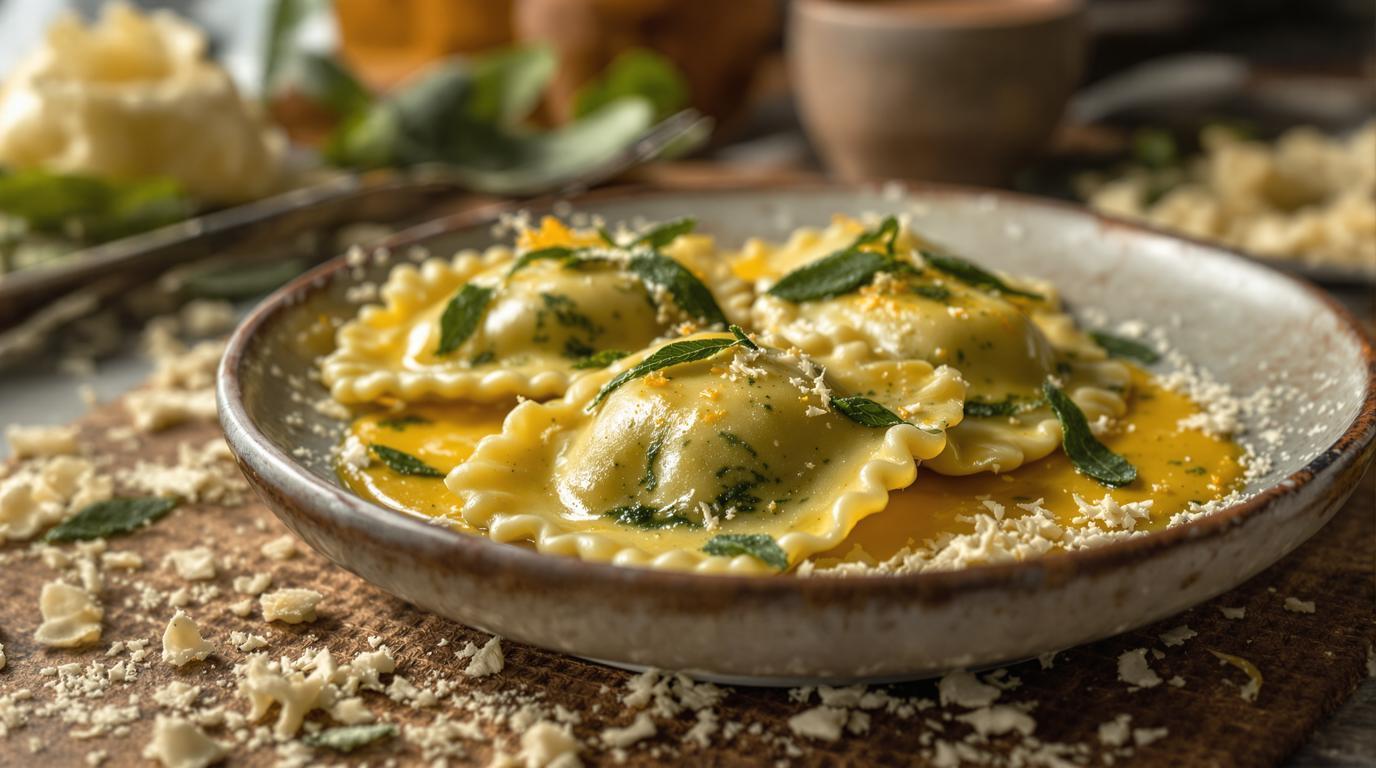The first time I created homemade spinach ricotta ravioli was after returning from Emilia-Romagna, where a local nonna showed me her family recipe passed down through generations. What struck me wasn’t just the delicate pasta or the herbaceous filling, but the meditative rhythm of creating each perfect pocket. This recipe captures that essence – the silky dough yielding between your fingers, the aromatic filling, and that magical moment when the first ravioli floats to the surface of simmering water, signaling its readiness to be savored.
The Story
Spinach and ricotta ravioli exemplifies northern Italian cuisine’s elegant simplicity. While appearing in restaurant menus worldwide, the homemade version delivers a textural experience that’s impossible to replicate commercially. Originally created as a practical way to stretch ingredients during leaner times (particularly during religious fasting days), these “ravioli di magro” transformed humble ingredients into something extraordinary. The key revelation? The quality of your ricotta fundamentally transforms this dish – seek out fresh, artisanal options whenever possible.
Ingredients Spotlight
For the pasta dough:
• 3⅓ cups (400g) “00” flour (all-purpose works in a pinch)
• 4 large eggs, room temperature
• ½ tsp salt
• Semolina flour for dusting
For the filling:
• 8oz (225g) fresh spinach (or 4oz/115g frozen, thawed and squeezed dry)
• 1lb (450g) fresh ricotta cheese
• 4oz (115g) freshly grated Parmigiano-Reggiano
• 1 large egg
• ¼ tsp freshly grated nutmeg
• Salt and freshly ground black pepper
For the sage butter sauce:
• 6 tbsp (85g) unsalted butter
• 8-10 fresh sage leaves
• Additional grated Parmigiano-Reggiano for serving
Step-by-Step Guide
1. Create the pasta dough: Form a flour volcano on your work surface, crack eggs into the center with salt, and gradually incorporate flour using a fork. Once rough dough forms, knead for 8-10 minutes until smooth and elastic. Wrap in plastic and rest for 30 minutes at room temperature.
2. Prepare the filling: Blanch fresh spinach in boiling salted water for 30 seconds, then immediately plunge into ice water. Squeeze thoroughly to remove excess moisture (this is crucial!) and finely chop. Mix with ricotta, Parmigiano, egg, nutmeg, salt, and pepper until well combined.
3. Roll the pasta: Divide dough into quarters. Working with one piece at a time (keep others covered), roll through pasta machine, gradually reducing thickness to second-thinnest setting (usually #6). Alternatively, roll by hand to approximately 1/16-inch thickness.
4. Form ravioli: Place 1 tablespoon-sized mounds of filling 2 inches apart on pasta sheet. Lightly brush water around each mound, cover with second sheet, and press firmly to seal, pushing out any air bubbles. Cut into squares or rounds and transfer to a semolina-dusted tray.
5. Cook the ravioli: Bring a large pot of generously salted water to a gentle boil. Cook ravioli in batches for 2-3 minutes until they float to the surface. Remove with a slotted spoon to a warm plate.
6. Make the sage butter: While ravioli cook, melt butter in a large skillet over medium heat until it begins to foam. Add sage leaves and cook until butter turns light golden and smells nutty (about 3 minutes). Immediately add cooked ravioli to the pan, gently tossing to coat.
Expert Techniques
The difference between good and exceptional ravioli lies in the details. Keep your pasta sheets slightly thicker in the center where the filling goes and thinner at the edges for proper sealing. When cooking, don’t trust timing alone – look for that telltale float to the surface, then give them 30 more seconds. For the filling, drain ricotta in a fine-mesh sieve lined with cheesecloth for 1-2 hours before using to remove excess moisture and achieve a more concentrated flavor.
Chef’s Note: The true test of properly made ravioli is the “window test” – hold a sheet of your rolled dough up to the light. You should be able to see your hand’s silhouette through it, but not distinct fingers. This thickness ensures the pasta cooks quickly but won’t tear during boiling.
Presentation & Pairing Ideas
Serve immediately on warmed plates, spooning additional sage butter over top. Finish with a light dusting of freshly grated Parmigiano and a crack of black pepper. For a complete experience, pair with a crisp white wine like Pinot Grigio or Arneis from Piedmont.
For a seasonal twist, incorporate finely minced herbs like thyme or tarragon into your pasta dough in spring, or replace spinach with finely chopped wild mushrooms in fall. For a luxurious upgrade, drizzle with white truffle oil just before serving.
Like the perfect focaccia or a silky flan napolitano, mastering homemade ravioli is about embracing the process. The final dish should reflect your personal touch – perhaps add lemon zest to brighten the filling or incorporate herbs from your garden. Remember that making pasta connects you to centuries of tradition, but your version becomes part of your own culinary story. Like French madeleines, these ravioli carry the imprint of their maker’s hands – imperfections and all.
